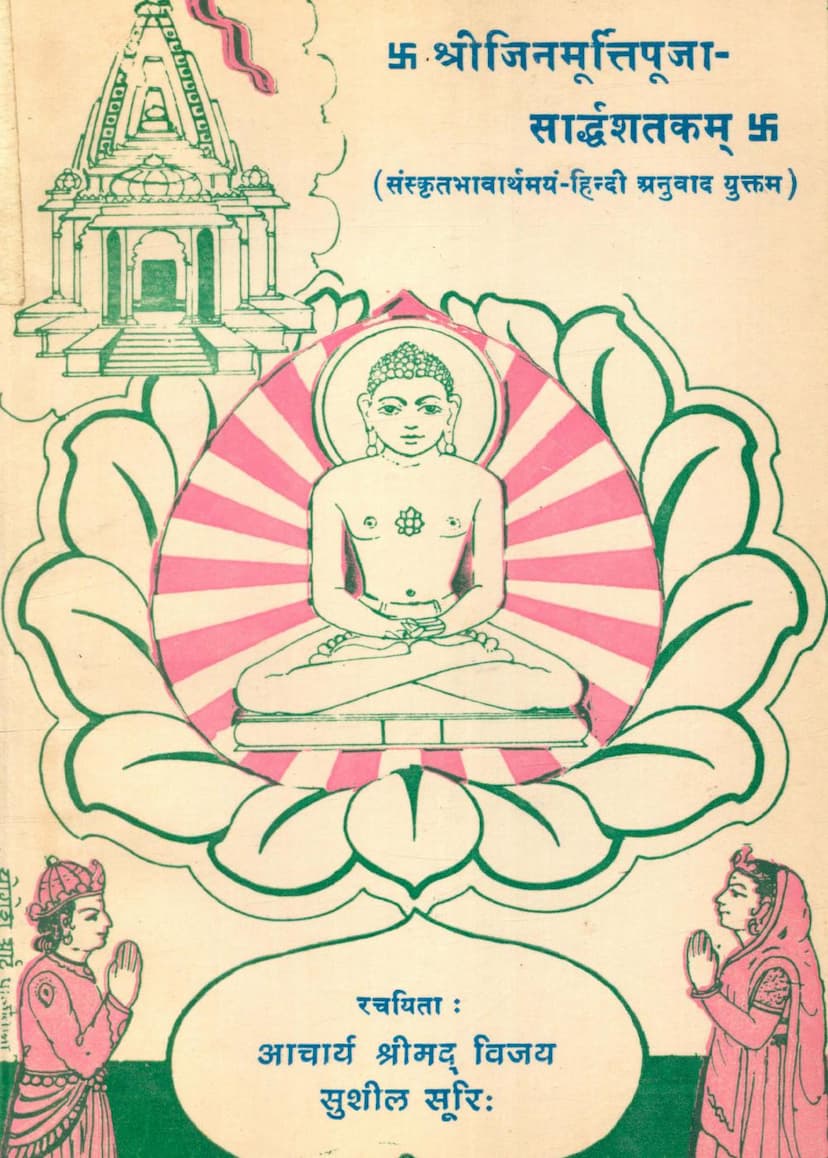Jinmurti Pooja Sarddhashatakam
Added to library: September 2, 2025

Summary
Here's a comprehensive summary of the Jain text "Jinmurti Pooja Sarddhashatakam" by Sushilsuri, based on the provided pages:
Book Title: Jinmurti Pooja Sarddhashatakam (A Century and a Half on the Worship of Jin Idols)
Author: Acharya Shrimad Vijay Sushil Suri
Publisher: Sushil Sahitya Prakashan Samiti
Overview:
"Jinmurti Pooja Sarddhashatakam" is a significant Jain text authored by the esteemed Acharya Sushil Suri. The book is dedicated to elaborating on and validating the practice of idol worship (Murti Pooja) within Jainism. It argues for the antiquity, authenticity, and spiritual efficacy of worshipping the idols of Tirthankaras and other revered figures in Jain tradition. The text is presented with Sanskrit verses, their philosophical explanations (Bhavartha), and Hindi translations, making it accessible to a wider audience.
Key Themes and Arguments:
-
Authenticity and Antiquity of Idol Worship: The book firmly establishes that idol worship is not a later addition to Jainism but has been a sanctioned and essential practice since ancient times, supported by Jain Agamas and other scriptures. It references historical evidence of temples and idols across India.
-
The Purpose and Efficacy of Idol Worship:
- Spiritual Upliftment: Idol worship is presented as a means to focus the mind, achieve spiritual concentration, and cultivate virtues like devotion, love, and peace.
- Overcoming Difficulties: The text emphasizes that worshipping Jin idols can help overcome obstacles, sorrows, poverty, and afflictions. The idols serve as a focal point for divine grace and spiritual support.
- Path to Liberation: The ultimate goal of idol worship, like all Jain practices, is presented as the attainment of liberation (Moksha). The idols are seen as guiding beacons on this path.
-
The Four Nykhepas (Categories of Understanding): A core concept discussed is the importance of understanding the Tirthankaras and their representations through the four Nykhepas:
- Naam (Name): The name of the Tirthankara.
- Sthapana (Installation/Representation): The idol or image itself, which represents the Tirthankara.
- Dravya (Substance): The spiritual essence or the soul of the Tirthankara.
- Bhava (Inner State/Devotion): The internal devotion and contemplation of the worshipper. The book stresses that neglecting any of these aspects can hinder spiritual progress.
-
Critique of Idol Worship Opponents: The text addresses and refutes common objections raised by those who oppose idol worship. It argues that the power of devotion and faith is paramount, and the idol serves as a catalyst for these inner states. It uses analogies like the efficacy of a medicinal herb or the power of a mantra to illustrate how even seemingly inanimate objects (or sounds) can have profound effects when imbued with spiritual significance and faith.
-
Examples and Narratives:
- Lord Rishabhadeva and Bharat Chakravarti: The book includes narratives from Jain tradition, notably the story of Bharat Chakravarti, the first Chakravarti and son of Lord Rishabhadeva. It highlights Bharat's devotion, his construction of temples and idols, and his exemplary life, demonstrating the practical application and benefits of idol worship.
- King Shripal and Madana-Mayanasundari: Another significant narrative details the story of King Shripal, afflicted with leprosy, and his devoted wife Madana-Mayanasundari. Through their sincere worship of the idol of Lord Shantinatha, particularly the ritualistic bath (Snana), Shripal was miraculously cured. This story serves as a powerful testament to the spiritual efficacy of idol worship.
- Lord Shantinatha's Idol: The story of Lord Shantinatha's idol being found and re-installed after being buried emphasizes the enduring power and presence of the sacred idols.
-
The Role of Temples and Rituals: The text advocates for the construction and maintenance of temples (Chaityas) as sacred spaces for worship. It also elaborates on the importance of various rituals, such as the Snana (bathing) and the specific ways of offering prayers and devotion.
-
The Superiority of Jain Worship: The book implicitly and explicitly positions Jain idol worship as a supreme path to spiritual well-being and liberation, drawing parallels with other practices only to highlight the unique comprehensiveness and efficacy of the Jain approach.
-
The Author's Devotion: The dedication and the introductory sections reveal the author's deep reverence for his gurus (Param Pujya Acharya Shrimad Vijay Nemisurishwarji, Param Pujya Acharya Shrimad Vijay Lavanyasurishwarji, Param Pujya Acharya Shrimad Vijay Dakshasurishwarji) and his own lineage. The entire work is presented as a humble offering of devotion.
Structure and Presentation:
- The text is composed of 150 verses (Sarddhashatakam implies 150, though the verses provided reach up to 148).
- Each verse is presented in Sanskrit (Mool Shloka).
- Followed by a detailed Sanskrit explanation (Sanskrit Bhavartha).
- And finally, a Hindi translation of the verse and its explanation.
- The book includes introductory and concluding remarks, acknowledgments, and dedications, emphasizing the collaborative effort and spiritual lineage involved in its publication.
Conclusion:
"Jinmurti Pooja Sarddhashatakam" is a comprehensive treatise that serves as a strong defense and detailed exposition of Jain idol worship. It aims to dispel doubts, provide scriptural and anecdotal evidence, and inspire devotees to engage in the worship of Jin idols with faith, devotion, and understanding, ultimately leading them towards spiritual progress and liberation. The book reflects the author's profound knowledge, devotional fervor, and commitment to propagating the Jain faith.